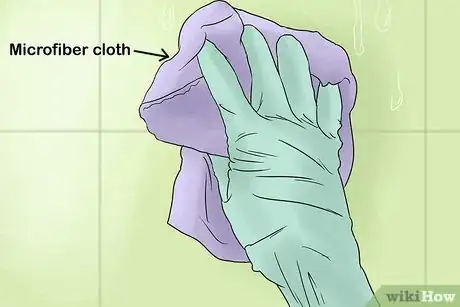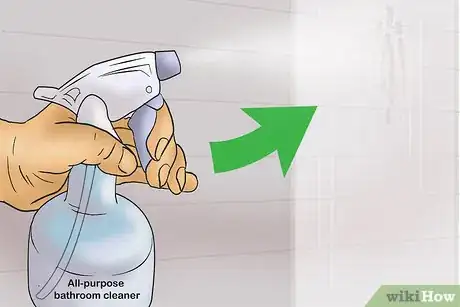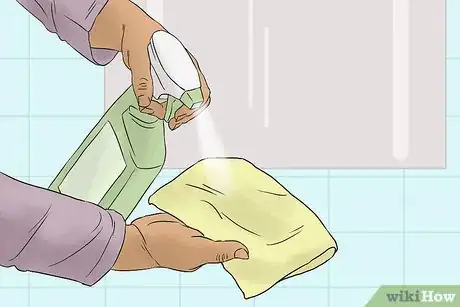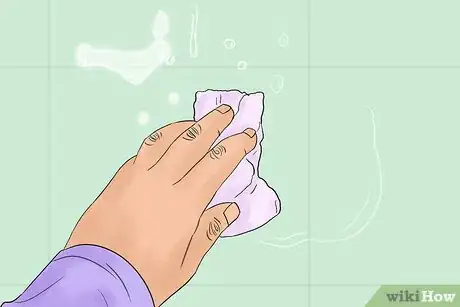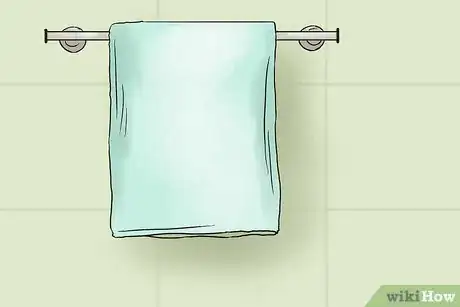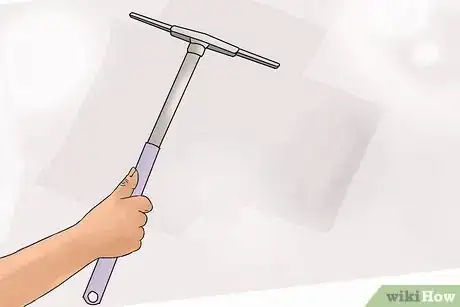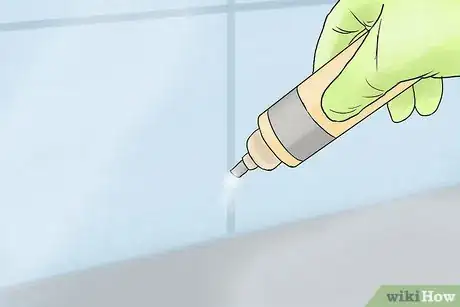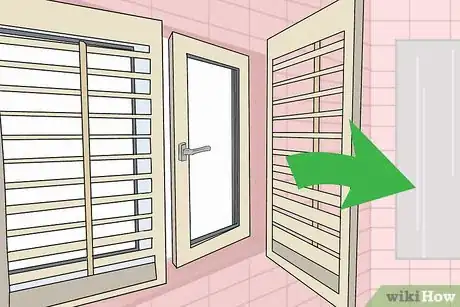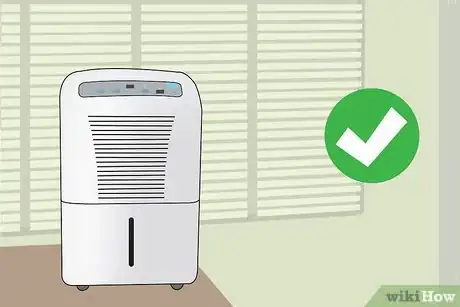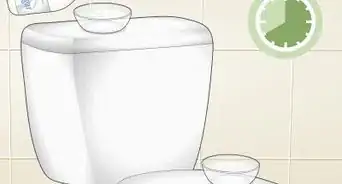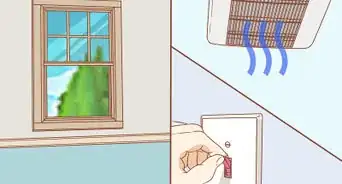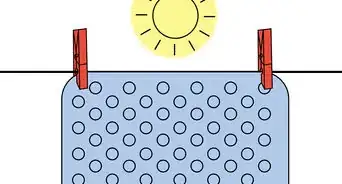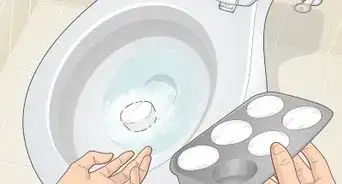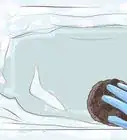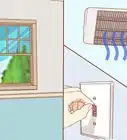This article was co-authored by Michelle Driscoll, MPH. Michelle Driscoll is the Owner of Mulberry Maids, which is based in Fort Collins, Colorado. With five years of experience, her business specializes in cleaning homes and small offices. She holds a Masters in Public Health from the Colorado School of Public Health. Additionally, Mulberry Maids has an A+ rating from the Better Business Bureau.
There are 11 references cited in this article, which can be found at the bottom of the page.
This article has been viewed 136,987 times.
Heat and moisture accumulate on a regular basis in bathrooms, providing the perfect environment for mold to grow. Not only can mold impact the appearance of your bathroom, but it can also cause damage to your walls, floors, and ceilings. Mold prevention is essential to keeping your bathroom in good working order.
Steps
Keeping the Bathroom Clean
-
1Dust your bathroom at least once per week. Since dust is a food source for mold and mold spores travel by air to settle on any surface, you must dust everything in your bathroom regularly to prevent mold growth. Use a lightly dampened microfiber cloth to wipe all surfaces, starting high and working your way down to lower areas.[1]
-
2Spray all-purpose bathroom cleaner on all the surfaces in your bathroom weekly. Go over your bathtub, sinks, and toilet thoroughly with a microfiber cloth and all-purpose bathroom cleaner.[2] Follow the directions on your cleaning product and allow the cleaning properties to disinfect bathroom surfaces completely before rinsing it down the drain or wiping it away.Advertisement
-
3Clean bathroom mirrors and windows with glass cleaner. Spray glass cleaner on a microfiber cloth and wipe your mirror and windows from top to bottom using an “s” pattern. Afterward, buff out any streaks left behind.[3]
-
4Wipe everything dry. Use a few paper towels to quickly retrace your cleaning steps to rid the bathroom of all moisture. Additionally, wipe any water lingering in the sink basin, in the tub, or on any other surfaces.[4]
-
5Wash shower curtain liners and bathroom rugs often. These items get wet every time they’re used, so it’s necessary to wash them and let them air dry every one or two weeks.
- Throw your plastic liner in the washing machine along with a load of whites, detergent, and a dash of baking soda.[5] After it’s clean, hang the liner out so it can air dry.
- Wash your bathroom rug in the washing machine with cold water and a gentle laundry soap. Tumble the rug dry on the coolest heat setting possible.[6]
-
6Keep bathroom towels hung up. Avoid tossing towels onto the bathroom floor when you’re done using them. Doing this keeps your towels from drying and contributes to the moist environment which encourages mold growth. Install a towel rod, wall hooks, or door hooks, if you don’t already have designated hanging areas.
Eliminating Moisture Accumulation
-
1Find and fix leaks in your bathroom. Feel around pipes and seals attached to the toilet and sinks in your bathroom for leaks. Make sure to do this regularly, because time makes all the difference when trying to prevent mold growth.[7] If leaks are present, contact a plumber to repair them or take matters into your own hands by fixing them yourself.
-
2Don’t keep loofahs, bath toys, or bathing products in the bath tub or shower. Shampoo, conditioner, body wash, washcloths and similar items can give mold a potential place to hide.[8] Wipe these items dry or squeeze all of the water out after each use and store them in a towel closet or somewhere else dry between showers.
-
3Squeegee away excess water after showering. After each shower, go over the walls of the shower in a vertical swiping motion with a squeegee so that you can quickly and easily get leftover water into the drain instead of allowing it to cling to the walls. Keeping shower walls dry contributes greatly to creating a low level of moisture in the bathroom.[9]
-
4Seal grout lines in tile flooring annually. Apply a standard grout sealer to the spaces between your bathroom tiles each year to waterproof them.[10] If at any point you have a particularly difficult time keeping your grout mold-free, you can also scrub it with bleach and a toothbrush or replace it completely by scraping it out with a flat screwdriver.
Providing Ventilation
-
1Keep the exhaust fan on during and after your showers. The fan will help circulate air and reduce steam while you shower in addition to helping the bathroom to dry faster when you are finished.[11]EXPERT TIP
"When you're done showering, keep the fan on for 30 minutes and open a bathroom window, if you have one."
Michelle Driscoll is the Owner of Mulberry Maids, which is based in Fort Collins, Colorado. With five years of experience, her business specializes in cleaning homes and small offices. She holds a Masters in Public Health from the Colorado School of Public Health. Additionally, Mulberry Maids has an A+ rating from the Better Business Bureau.
Michelle Driscoll, MPH
Founder, Mulberry Maids Michelle Driscoll, MPH
Michelle Driscoll, MPH
Founder, Mulberry Maids -
2Open your bathroom windows and shut the door. Allowing fresh air to enter your bathroom will provide a better air flow and assist with drying the room more efficiently. Close the bathroom door to contain the moisture produced and open the bathroom windows while you bathe to naturally disperse it.[12]
-
3Lower the humidity with a dehumidifier. Dehumidifiers are a great choice for creating ventilation and preventing mold growth, especially if you live in a hot, humid climate. Dehumidifiers can make a huge difference by significantly reducing the amount of moisture in the air.[13]
-
4Turn on the air conditioner. Air conditioners not only cool down the air but also condition it by removing moisture. Install a window AC unit and keep the temperature a little cooler to create ventilation and prevent growth.[14]
-
5Leave the shower door or curtain open after showering. Leaving your shower open promotes evaporation and helps your shower dry out more quickly. Closing the door or curtain slows down the drying process, creating the kind of moist environment where mold and bacteria flourish.
Expert Q&A
-
QuestionWhat kills bathroom mold?
 Michelle Driscoll, MPHMichelle Driscoll is the Owner of Mulberry Maids, which is based in Fort Collins, Colorado. With five years of experience, her business specializes in cleaning homes and small offices. She holds a Masters in Public Health from the Colorado School of Public Health. Additionally, Mulberry Maids has an A+ rating from the Better Business Bureau.
Michelle Driscoll, MPHMichelle Driscoll is the Owner of Mulberry Maids, which is based in Fort Collins, Colorado. With five years of experience, her business specializes in cleaning homes and small offices. She holds a Masters in Public Health from the Colorado School of Public Health. Additionally, Mulberry Maids has an A+ rating from the Better Business Bureau.
Founder, Mulberry Maids Vinegar is a great non-toxic mold killer. You can either mix 1:1 vinegar and water or you can use undiluted vinegar if you have a significant amount of mold build up. Spray the mold with vinegar and scrub away the mold spores. Another natural mold killer is Borax. Mix 1 cup of Borax with 1 gallon of water and spray the solution on the mold. Alternatively, you can use a bleach solution by mixing 1 part bleach to 10 parts water.
Vinegar is a great non-toxic mold killer. You can either mix 1:1 vinegar and water or you can use undiluted vinegar if you have a significant amount of mold build up. Spray the mold with vinegar and scrub away the mold spores. Another natural mold killer is Borax. Mix 1 cup of Borax with 1 gallon of water and spray the solution on the mold. Alternatively, you can use a bleach solution by mixing 1 part bleach to 10 parts water. -
QuestionHow do you stop mold from growing in your bathroom?
 Michelle Driscoll, MPHMichelle Driscoll is the Owner of Mulberry Maids, which is based in Fort Collins, Colorado. With five years of experience, her business specializes in cleaning homes and small offices. She holds a Masters in Public Health from the Colorado School of Public Health. Additionally, Mulberry Maids has an A+ rating from the Better Business Bureau.
Michelle Driscoll, MPHMichelle Driscoll is the Owner of Mulberry Maids, which is based in Fort Collins, Colorado. With five years of experience, her business specializes in cleaning homes and small offices. She holds a Masters in Public Health from the Colorado School of Public Health. Additionally, Mulberry Maids has an A+ rating from the Better Business Bureau.
Founder, Mulberry Maids If you notice mold growth on your bathroom walls, you can create a bleach/water or vinegar/water solution and scrub down all the walls and the ceiling. Be sure to dry the walls after scrubbing. After the mold removal, you should be adamant about keeping your exhaust fan on for at least thirty minutes following your shower. It is always a good idea to check your exhaust fan, as it may need to be cleaned out. In addition, you should open a window or door if you are able to. Lastly, you can use a dehumidifier in your bathroom to help reduce the amount of moisture in the air, thus reducing the development of mold.
If you notice mold growth on your bathroom walls, you can create a bleach/water or vinegar/water solution and scrub down all the walls and the ceiling. Be sure to dry the walls after scrubbing. After the mold removal, you should be adamant about keeping your exhaust fan on for at least thirty minutes following your shower. It is always a good idea to check your exhaust fan, as it may need to be cleaned out. In addition, you should open a window or door if you are able to. Lastly, you can use a dehumidifier in your bathroom to help reduce the amount of moisture in the air, thus reducing the development of mold. -
QuestionHow do I prevent mold on my bathroom ceiling?
 Michelle Driscoll, MPHMichelle Driscoll is the Owner of Mulberry Maids, which is based in Fort Collins, Colorado. With five years of experience, her business specializes in cleaning homes and small offices. She holds a Masters in Public Health from the Colorado School of Public Health. Additionally, Mulberry Maids has an A+ rating from the Better Business Bureau.
Michelle Driscoll, MPHMichelle Driscoll is the Owner of Mulberry Maids, which is based in Fort Collins, Colorado. With five years of experience, her business specializes in cleaning homes and small offices. She holds a Masters in Public Health from the Colorado School of Public Health. Additionally, Mulberry Maids has an A+ rating from the Better Business Bureau.
Founder, Mulberry Maids The best way to prevent the development of mold is to provide proper ventilation. Keep the exhaust fan on during and after your shower. If your bathroom is prone to mold, keep your exhaust fan on for about thirty minutes following your showers. In addition, if you are able to open a window or door during your shower, that will help with the ventilation. You may also want to invest in a dehumidifier, which can significantly reduce the amount of moisture in the air. Lastly, if you notice mold growth on your bathroom ceiling, you should immediately clean it off to prevent it from spreading. You can use a bleach solution or a vinegar solution (but do not mix bleach and vinegar) to scrub the mold off the ceiling.
The best way to prevent the development of mold is to provide proper ventilation. Keep the exhaust fan on during and after your shower. If your bathroom is prone to mold, keep your exhaust fan on for about thirty minutes following your showers. In addition, if you are able to open a window or door during your shower, that will help with the ventilation. You may also want to invest in a dehumidifier, which can significantly reduce the amount of moisture in the air. Lastly, if you notice mold growth on your bathroom ceiling, you should immediately clean it off to prevent it from spreading. You can use a bleach solution or a vinegar solution (but do not mix bleach and vinegar) to scrub the mold off the ceiling.
Warnings
- Mold can be hazardous to your health. If the problem in your bathroom is not addressed, it could lead to allergic reactions, fungal infections, and poison by mycotoxins created by the mold.⧼thumbs_response⧽
References
- ↑ http://cleanmyspace.com/how-to-clean-a-bathroom/
- ↑ http://cleanmyspace.com/how-to-clean-a-bathroom/
- ↑ http://cleanmyspace.com/how-to-clean-a-bathroom/
- ↑ http://www.onegoodthingbyjillee.com/2016/02/how-to-clean-your-bathroom-like-pro.html
- ↑ http://www.apartmenttherapy.com/how-toclean-pla-23835
- ↑ https://www.merrymaids.com/blog/quick-tips/how-to-wash-bathroom-rugs
- ↑ https://www.nachi.org/mold.htm
- ↑ https://www.houselogic.com/by-room/bathroom-laundry/bathroom-mold/
- ↑ https://www.familyhandyman.com/cleaning/mold-and-mildew/how-to-prevent-bathroom-mold/view-all
- ↑ https://www.familyhandyman.com/cleaning/mold-and-mildew/how-to-prevent-bathroom-mold/view-all
- ↑ https://www.houselogic.com/by-room/bathroom-laundry/bathroom-mold/
- ↑ http://www.envirovent.com/blog/9-tips-to-control-mould-before-it-controls-you/
- ↑ http://www.webmd.com/women/home-health-and-safety-9/mold-mildew?page=2
- ↑ https://asm-air.com/airconditioning/how-do-you-prevent-mold-5-tips/
- ↑ https://www.ahs.com/home-matters/quick-tips/prevent-mold-and-mildew-in-bathroom
About This Article
To prevent an infestation of mold, dust your bathroom at least once a week. Disinfect the bathtub, sinks, and toilets using an all-purpose cleaner, and disinfect the mirrors and windows using a glass cleaner. Make sure to machine wash your shower curtains, bathroom rugs, and towels often. To keep moisture from building up, fix any leaks around your toilet or sinks and, once a year, reseal the grout lines in tile flooring. Keep loofahs, bath toys, and bath products in a dry area. For tips on increasing ventilation to reduce mold-causing moisture, read on!
